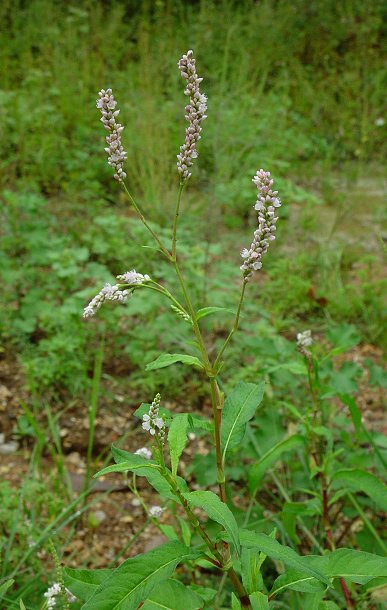Persicaria pensylvanica (L.) M. Gmez
Pinkweed

Native
CC = 1
CW = -3
MOC = 92
© DETenaglia
Persicaria pensylvanica (L.) M. GmezPinkweed | |
 |
Native CC = 1 CW = -3 MOC = 92 |
© DETenaglia |
|
Family - Polygonaceae Habit - Taprooted annual forb. Stems - Ascending to erect, to 2 m, sometimes from a spreading base, glabrous or appressed-hairy toward the tip, not also gland-dotted. Ocreae persistent, usually tearing with age, 5-20 mm long, somewhat inflated toward the base, tan to light brown and papery throughout, lacking a flange of tissue at the tip, the margin entire or nearly so, lacking bristles or occasionally with short, slender, extensions of the veins to 0.5 mm long, the surface glabrous or appressed-hairy, not gland-dotted.
Leaves - Alternate, petiolate, sheathing. Petioles 0.1-3.0 cm long. Leaf blades 4-18 cm long, 1.0-4.8 cm wide, lanceolate, angled at the base, angled to a sharply pointed tip, the surfaces glabrous or variously appressed- to spreading-hairy, the hairs sometimes gland-tipped, the undersurface sometimes with impressed glands, the upper surface sometimes with a reddish or purplish, chevron- to triangular-shaped marking. Margins antrorse strigillose.
Inflorescence - Terminal and axillary racemes, usually several to numerous per main stem, 0.5-5.0 cm long, 5-15 mm wide, erect or ascending, usually straight, dense, uninterrupted, the stalk 1-7 cm long, glabrous or pubescent with conspicuous, dark, stalked glands. Ocreolae overlapping, the margins entire or with minute bristlelike teeth to 0.5 mm long, the surface glabrous, occasionally sparsely gland-dotted (the dots usually inconspicuous and pale).
Flowers - Plants homostylous. Flowers perfect, 2-14 per fascicle, all similar. Perianth greenish white to pink, bell-shaped, not gland-dotted, the tepals 5, 3.0-3.6 mm long, fused below the midpoint, the nerves relatively prominent, irregularly few-branched (not anchor-shaped). Stamens 6-8, not exserted, the anthers yellow, pink, or red. Styles 2-branched from near the base, not exserted, not persistent. Stigmas globose. Ovary green, glabrous, compressed, rotund, 0.9 mm in diameter.
Fruits - Achenes 2.0-3.5 mm long, 1.8-3.0 mm wide, not or only slightly exserted, discoid or rarely 3-angled, beakless, the faces somewhat concave, lacking a central hump, the surface smooth, brown to black, shiny. Flowering - May - October. Habitat - Streambanks, swamps, pond margins, sloughs, marshes, moist disturbed areas. Lookalikes - Persicaria bicornis, P. maculosa, P. glabra. Origin - Native to the U.S. Other info. - This wetland species is common throughout Missouri, and also occurs across most of the continental U.S. and into Canada. The perianth color is variable, with flowers in a single inflorescence sometimes ranging from white to pink. Though not absolutely diagnostic, the presence of stalked glands on the inflorescence stalk strongly suggests this species. See the page in this website for P. bicornis for a discussion of heterostyly and the differentiation of the two species. Photographs taken off Hwy 60, Carter County, MO., 8-31-03 (DETenaglia); also at Shaw Nature Reserve, Franklin County, MO, 9-16-2006; near Creve Coeur Lake, St. Louis County, MO, 9-26-2019, along the Katy Trail near Dutzow, Warren County, MO, 9-29-2020, and Riverlands Migratory Bird Sanctuary, St. Charles County, MO, 10-13-2020 (SRTurner). |